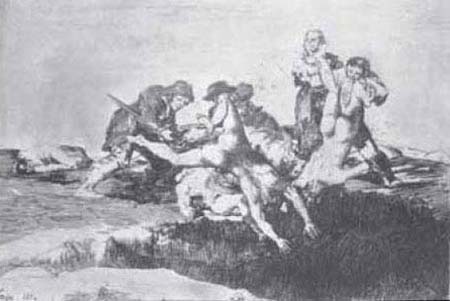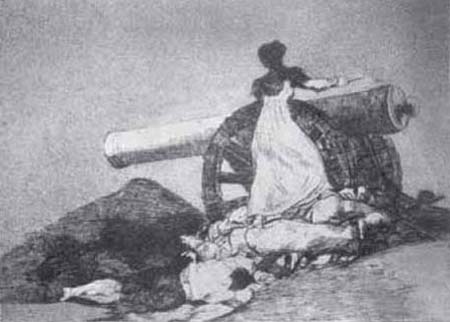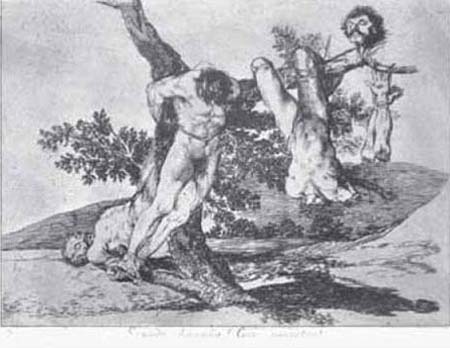2 The work of Goya
Goya developed from a decorator of churches to a court artist, accomplished portraitist, satirical graphic artist and a painter of dark, nightmare visions. His work at court, for Carlos III and Carlos IV, involved both decorative work and a series of portraits of key figures who moved in court circles. As his official, public work became more sought after, however, he developed a parallel career as a graphic artist that seemed to express more freely a private view of the injustices, vices, follies and inhumanity of contemporary society. This shift coincided with his own increasing deafness. It also intensified as Spain was wracked by the grief and suffering of war provoked by the Napoleonic invasion. Some of the art that emerged from the Peninsular War and its aftermath suggested a shift of interest away from Enlightenment reform and towards more troubled, private fantasies and preoccupations. And yet the public at large perhaps was not ready for this. Although Goya's first major engraved series, Los Caprichos, went briefly on sale before being withdrawn, his later series, Disasters of War, was not published during his lifetime.
Exercise 1
Click on the links below and view the video. The video is supplied in three sections, and you should watch them in the order they appear below. As you do so, think about the following questions. Don't read the discussion until you have finished.
How is the influence of the Enlightenment evident in Goya's early career?
How were the effects of the Napoleonic invasion reflected in his art?
In what ways did Goya's art move towards a Romantic concern with the darker forces of unreason, mystery and suffering?
Click below to view part 1 of the video.
Transcript: Part 1
Click below to view part 2 of the video.
Transcript: Part 2
Click below to view part 3 of the video.
Transcript: Part 3
Discussion
After beginning to work at the Spanish court Goya painted the portraits of many of Spain's leading Enlightenment figures. Madrid was at the time a centre of enlightened developments in science, astronomy and the arts. Although we cannot infer from this any clear allegiance by Goya to the ideals of the Enlightenment, he did frequent a milieu receptive to Enlightenment ideas, even if these ideas were not yet widespread in Spain as a whole. You may have noticed that they were largely restricted to court circles and to the ruling intelligentsia. His advertisement for the print series, Los Caprichos, also betrayed some sharing of the Enlightenment's aim to correct folly, injustice and vice. (You may also be interested to know that Godoy commissioned from Goya a series of allegorical paintings on the Enlightenment themes of science, industry, agriculture and commerce, thus suggesting his own Enlightenment credentials.)
In the Second of May 1808, the Third of May 1808 and the engraved series, Disasters of War, the Napoleonic invasion is seen as an act of violent oppression that acted as a spur to patriotic fervour, heroism and courage. War is seen primarily as a crime against humanity.
The Disasters of War and the so-called Black Paintings are among the later works of Goya that suggest indefinable, mysterious or irrational subjects and a unique, original artistic vision. War is seen mainly as an indiscriminate creator of victims and suffering. Goya's view on the Academy rebels against the tyranny of rules, and it might be argued that there is a parallel between the unleashing of the irrational forces of war and developments in his artistic outlook. There had, of course, been signs of the grotesque and the irrational in earlier works such as Los Caprichos. But there the grotesque, the superstitious and the unjust had been contained within an essentially moralising and satirical framework. In the later works the reforming powers of reason seem absent or irrelevant, and the balance between empirical observation and fantasy seems to shift towards the latter. The light of reason gives way to the dark recesses of the imagination.
In his 1792 address to the San Fernando Royal Academy of Fine Arts, Goya had stressed the importance to artists of studying nature, as opposed to the uninformed, servile copying of Greek statues or the following of rules proposed by those who have written about art:
It is impossible to express the pain that it causes me to see the flow of the perhaps licentious or eloquent pen (that so attracts the uninitiated) and fall into the weakness of not knowing in depth the material of which he writes; What a scandal to hear nature deprecated in comparison to Greek statues by one who knows neither the one, nor the other, without acknowledging that the smallest part of Nature confounds and amazes those who know most! What statue, or cast of it might there be, that is not copied from Divine Nature? As excellent as the artist may be who copied it, can he not but proclaim that placed at its side, one is the work of God, the other of our miserable hands? He who wishes to distance himself, to correct it [nature] without seeking the best of it, can he help but fall into a reprehensible and monotonous manner, of paintings, of plaster models, as has happened to all who have done this exactly?
(Quoted in Tomlinson, 1994, p. 306)



Observation of nature, in the form of his contemporaries and their lives, certainly nourished Goya's own art. Increasingly, however, he engaged in a liberated form of artistry in which imitation became subservient to creativity: this was one of the key shifts inherent in the move from Enlightenment to Romanticism. His etching from the Los Caprichos series, The Sleep of Reason Produces Monsters (Plate V2.1) encapsulates this shift as a contest of truth and imagination. When first drawn and etched in 1797, this was envisaged as a frontispiece and was accompanied by the caption: ‘The Author Dreaming. His only intention is to banish those prejudicial vulgarities and to perpetuate with this work of caprichos the sound testimony of truth.’ Creatures of the night represent those ‘prejudices’. We see owls and bats (which then represented ignorance and the forces of darkness) and a lynx, emblem of the power of sight. It is an ‘ignorant’ owl that prompts the artist into action. The total effect is one of ambiguity. Will darkness predominate in the artist's mind, or will his vigilance and alertness help to expose and banish these creatures of the night, as befitted the satirical intention of the series?
Click to view Plate V2.1 The Sleep of Reason Produces Monsters [Tip: hold Ctrl and click a link to open it in a new tab. (Hide tip)] .
